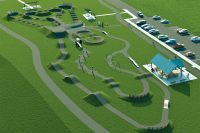The Naturalist's Corner: Live and die by Lake J
 Barred owl spotted on the Balsam Christmas Bird Count. Don Hendershot photo
Barred owl spotted on the Balsam Christmas Bird Count. Don Hendershot photo
Jan. 4, 2019 was a dreary day. It was more than that; it was a dreary Balsam Christmas Bird Count day. We have generally, since its inception 17 years ago, scheduled our Balsam CBC during the last count weekend. We did so because we have section leaders and others who also participate in other established area counts. Audubon’s count period ended on Jan. 4 this year so we didn’t really have a weather makeup date, besides most CBCs run rain or shine on the appointed date.
My group and one other met in the Walmart parking lot around 7:45 a.m. and it looked like, for a minute, we would have a somewhat dry start. But by the time we arrived at our first destination there was a light steady rain. So, we decided to do a little windshield birding — driving and looking and listening for activity. We were on Cabin Flats road and in the vicinity of the Balsam Community Center, and while it was rather damp, we were picking up a few birds.
We decided to drive up Sugarloaf Road adjacent Balsam Mountain Preserve. Because our compiler waited till just a couple of days before the count to contact BMP, we were unaware of a policy change that requires any/all guests to have permission from a member and/or be accompanied by an employee or an employee of Balsam Mountain Trust. I, personally, can’t believe the compiler waited so long to contact Balsam Mountain and feel that he should be held accountable … what? Oh, never min, I’m the compiler.
Anyway, BMP has always been our go-to ruffed grouse site, so we decided to poke around on its edges. Regrettably, we weren’t able to flush a grouse but while noodeling around on Sugarloaf Road in a drizzling rain I spied the dark unmistakable silhouette of a barred owl perched amidst a tangle of limbs and twigs. Turned out to be a good find — the only one for the count.
The rain tapered off around 10:30 a.m. and stayed away till around 4:30 p.m. And while the rain stayed away, the day remained dark and drippy. Not to say there aren’t high points, even on dark and drippy days. One came for us as we were nosing around near Barber’s Orchard fruit stand. A gentleman, curious about what seven people were doing standing around in the grey with binoculars near his antique store came out to greet us. Not only did Jim Picker regale us with anecdotes, he also opened a fence giving us access to his property where we found an American kestrel and the only yellow-rumped warbler of the day.
Another high point for our group was the fact Kefyn Catley, biologist/entomologist from Western Carolina University, was in our group and on a walk along Cabins Flats Kefyn was able to show us egg sacs from the lampshade spider. There are only 12 species of lampshade spiders in the world and six of them live in the Southern Appalachians — and you thought we only noticed birds.
Related Items
Back to birding, conditions were less than optimal and our tally showed it. We wound up with 66 species for the count, three or four below average. And while birding was tough in general, Lake Junaluska has been in the doldrums since late fall, and as the lake goes so goes the Balsam CBC. Last year 15 species of waterfowl were recorded at the lake and we wound up with 70 species, the most of any mountain count in the state. This year 12 species of waterfowl were recorded at the lake and we wound up with 66 species.
But even with the dampness, even with the doldrums, even with the low count, it was a wonderful time shared with like-minded folk and one rarity – a greater white-fronted goose was recorded from the Maggie Valley section.
Now if I can just remind our compiler to make sure we have access to BMP next year for our ruffed grouse…
(Don Hendershot is a naturalist and a writer who lives in Haywood County. He can be reached at This email address is being protected from spambots. You need JavaScript enabled to view it.)









